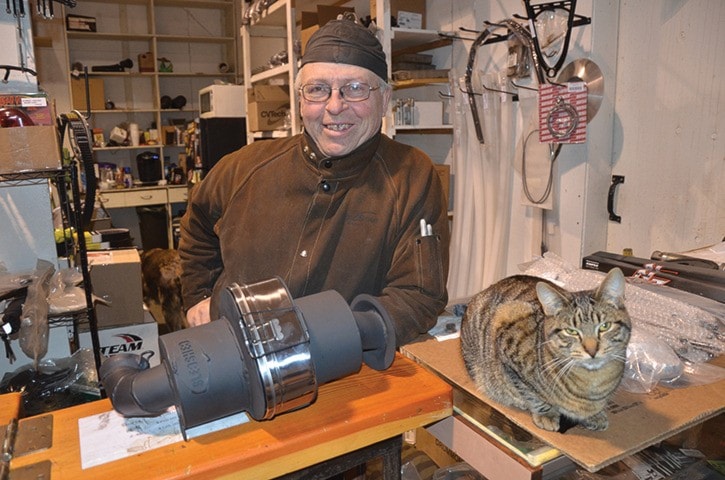Who is the most hardcore snowmobile motorhead in Revelstoke? To what extremes does he go to make souped up sleds growl and claw their way to the peak?
I set out in search of a the best representative of the niche sled subculture that puts the machine first.
Everyone pointed me towards “Turbo” Al Williams at the Boulder Mountain Sled Shed.
I’ll admit I was a bit worried as I drove past the giant Smokey Bear on my way to the shop. Cold-call interviews can easily go badly and turn into a teeth-gritting awkward session. What if it’s a room full of standoffish, grease-stained guys grunting answers at the stray who’s wandered into the pack’s den?
Boy, I couldn’t have been more wrong. There were grease-stained dudes – but Al Williams is the nicest, most welcoming guy I’ve met in a while.
The whip-smart sled guru is an expert welder, engineer, mechanic, physics experimenter, businessperson, pilot, product designer, manufacturer and star tinkerer – and he’s all self-taught, starting back on a Saskatchewan farm.
And now he makes a living converting snowmobiles into ovens.
Let me explain …
The Boulder Mountain Sled Shed is a repair shop. Their seasonal arc starts with the snowfall. First sledders crash into trees and rocks they can’t avoid, leading to minor repairs. More snow falls and they crash into rocks and stumps they can’t see, leading to bigger repairs. Then the snow gets deep so Williams and his crew deal with burned out motors. Then the snowpack firms up and hill climbers roll their sleds down hills and “bend it around a tree.” Once the snow melts, Williams gets onto his 2012 Harley Road Glide and goes fishing.
Williams and his tabby cat George greeted me at the counter. He was wearing a leather Harley-Davidson baseball cap, a suede welder’s jacket with Jiffy markers tucked into the sleeve and navy cargo pants. George wears stripes.
Repairs are actually a smaller part of the Sled Shed’s business. Williams manufactures custom ‘Sledshed’ cooking cans – modified exhaust parts fitted with a slot for a stainless steel cooking container. The part also boosts performance.
The can can slow cook the food if you’re trail riding, or get up to 450 degrees if you’re climbing in the alpine. “You can burn your bacon for sure,” he said.
There’s no recipe book, but the key is combining the food right. “A guy did a steak and lobster from the Boulder lot to the Boulder cabin,” Williams said – he started with the lobster frozen. Some restaurants in town sell foil-wrapped foods especially for the cookers.
They manufacture the exhaust attachments for many makes of sleds. The shop is an explosion of jagged metal parts, pipes and pieces. It has an order to it, but its organizational theme is ‘improvised.’ The smell of motor oil, metal and the cedar/birch mix in the stove fill the air.
Metal ‘jigs’ line the shops, many welded onto old car rims. They look like abstract metal sculptures and serve as guides as the pieces are cut and welded together.
After dozens of parts are welded together, they add ceramic paint and ship them to most continents in the world.
While I was there, an Albertan walked in and buys one. The young man also asked about some mechanical issues, and Williams threw out a very technical explanation, including memorized compression ratios and lots of tech jargon. “You only know by looking on your secondary helix,” he said. (I guess, like me, the fellow has no idea what a secondary helix is.)
Williams worked in all sorts of careers. He owned a sled dealership. He welded. He worked for Ford, but spent way too much time doing paperwork instead of actual mechanical work. “Being privateers we have the freedom to do that,” Williams said. “We build things.” Williams works with partners Peter Hermansen and Cathy Scott – and other employees.
He’s come up with several power adapters for sleds and has modified just about everything on them. His “Frankensled” out front isn’t recognizable from the the six-year-old floor model it started out as.
He designed, built and sold power adapters that boost power and compensate for oxygen and pressure losses at high altitude using “wave amplification physics” – coaxing some up to 260 horsepower.
Sadly, Williams thinks the jig is almost up for people like him. He saw the same thing happen with motorcycles over his lifetime. Growing up, he used to modify them for racing. Over time, the manufacturers caught on to the mods that enthusiasts were making and incorporated them into their factory designs. Nowadays, the racing motorbikes at the dealership are pretty close to as good as you can do.
Sleds are going in the same direction. He’s convinced he’s seen some of his earlier mods and retrofits on production sleds. “You’d swear they had cameras in a lot of these shops,” he said.
Williams and his partners have built the business from the ground up over the past 10 years, living frugally and avoiding bank financing. Seeing what they’ve accomplished through mental willpower and hard work, I’m not concerned they’ll be unable to adapt to the changes.
Oh, by the way, what’s the best sled out there for Revelstoke conditions? “Ski-Doo Summit X,” Williams said.
